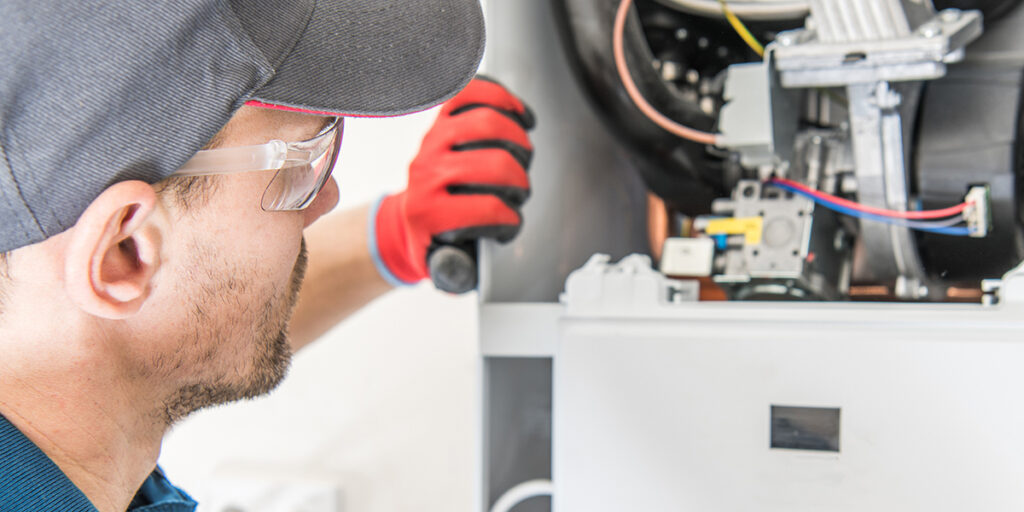Are you struggling to determine the ideal furnace size for your home? Trust Topline Heating & Air for a meticulous, professional job when you dial (717) 628-6825.
Pennsylvania’s cold winters warrant an adequately sized furnace to keep your home warm. It can be challenging to determine the right furnace, but those wondering, “What size furnace do I need?” significantly benefit from a new heating system. It’s essential to get the right size furnace.
The last thing you want is a furnace that’s the wrong size for your home and heating demands. It’s possible to estimate the size of the furnace you’ll need, but that doesn’t guarantee it’s the right size.
A skilled HVAC contractor in Bethel, PA, can help determine your furnace needs with a precise calculation. We provide you with all the information necessary to consider before you select a new furnace.
1. Your Home’s Size and Heating Needs
Before you ask the professionals, “What size furnace do I need?” you’ll need to know your home’s square footage. With this number, you can determine the correct heating capacity.
HVAC technicians describe the furnace size and how much heat it produces per hour in British thermal units (BTUs). BTUs are a measurement describing how much heat is necessary to warm a pound of water by one degree. Your furnace selection should at least meet your home’s BTU requirements.
Most home furnaces produce between 80,000 and 100,000 BTUs per hour. Depending on the size of your home, this could be more than adequate.
The larger your home, the more BTUs are necessary per square foot. Each square foot of area in your home requires between 30 and 60 BTUs to warm successfully. The following ranges describe how many BTUs are necessary for your furnace depending on home size:
- Houses up to 1,200 square feet require 35,000 to 75,000 BTUs.
- Houses up to 1,800 square feet require between 55,000 and 110,000 BTUs.
- Houses of 2,100 square feet require up to 125,000 BTUs.
2. The Climate You Live In
Your climate directly relates to the question, “What size furnace do I need?” You won’t need the same heating power in a warm environment as in a cold climate.
Different climate zones across the United States require different BTU levels. For example, Zone 4, with semi-arid conditions, has a heating factor of around 40 BTUs, while the Mediterranean climate of cities in Zone 2 has a lower heating factor of about 35 BTUs.
To determine how many BTUs your furnace needs, multiply your home’s square footage by the heating factor for your location’s climate zone.
3. Your Home’s Insulation
Insulation determines how well your home maintains its temperature. Poor insulation results in more chances for comfortable, warm air to escape through cracks in construction, such as the roof or damaged ductwork. Homes with adequate insulation stay warmer for longer.
If your home has old or damaged insulation, you’ll need a more energy-efficient option to keep your rooms warm. Homes with adequate insulation need a less powerful furnace. More insulation also means reduced energy bills when you run your furnace.
4. The Age of Your Home
Your home’s age is also helpful to consider when thinking about “What size furnace do I need?” as newer homes are better at keeping heat indoors. While it’s not impossible for older homes to maintain temperature effectively, new homes offer far more benefits than forcing a new furnace into an old house. Hot air tends to escape through cracks, crevices, and open spaces in an old home’s walls.
New homes have better insulation, windows and doors that seal correctly, and fewer structural issues that could result in heat loss. Older windows and doors may have problems sealing, leaving more opportunities for heat loss.
5. Furnace Efficiency Rating
The furnace efficiency rating describes how effective a furnace is at heating air. Most modern furnace efficiency ratings don’t surpass 90%, while older furnace models hover around 80%. Remember that the efficiency rating doesn’t guarantee your furnace will always be this efficient.
Despite putting out a certain number of BTUs per hour, the unit won’t put out this many unless operating at full efficiency. Because even the best furnaces’ efficiency ratings don’t surpass 95%, you’ll need to consider this information when calculating whether a furnace meets your home heating needs.
To ensure your furnace has enough heating power, you’ll need to consider a furnace with a heating capacity slightly larger than what you need based on square footage.
6. Potential Issues From an Improperly Sized Furnace
There are several potential ways an incorrectly sized furnace could affect your home. Knowing these possibilities will help you ensure your furnace is the right size. If you’re still looking for the answer to “What size furnace do I need?” it’s also helpful to consider the disadvantages in addition to the benefits of a new installation. These include:
- High energy bills due to a furnace that’s too small or large
- Increased wear and tear from constant operation
- Uneven cooling if the furnace is too small to keep up with cooling demands
- Short cycling if the unit is too large for the home
Significant wear and tear result in more repair needs, especially without regular maintenance. An HVAC technician can prevent this.
Call Topline Heating & Air for Furnace Installations and More
While it’s possible to determine the correct size furnace yourself, professional HVAC technicians and installers understand the ins and outs of furnace installations and can perform them accurately. They’ll calculate your home’s heating needs and help you select the best, most efficient model.
Are you still wondering, “What size furnace do I need?” Look no further than the skilled professionals at Topline Heating & Air for the answer. We have everything you need for successful installations.
Learn more about our air conditioner repair and installation services, then contact our experts to get a new furnace or air conditioner or fix your broken unit. Call our Honey Brook, PA, team at (717) 628-6825.



